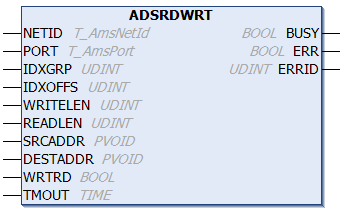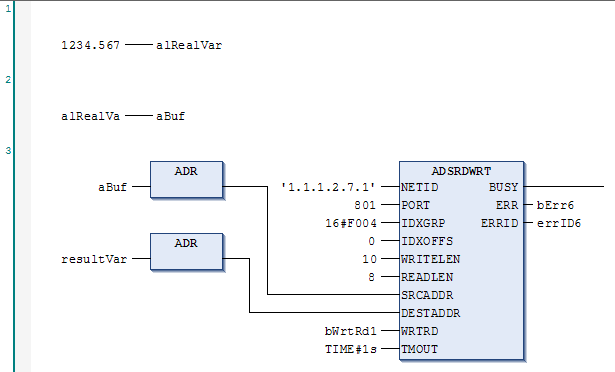ADSRDWRT

The function block executes a combined ADS read-write command. Data is transmitted to an ADS device (write) and its response data read with one call.
 Inputs
Inputs
VAR_INPUT
NETID : T_AmsNetId;
PORT : T_AmsPort;
IDXGRP : UDINT;
IDXOFFS : UDINT;
WRITELEN : UDINT;
READLEN : UDINT;
SRCADDR : PVOID;
DESTADDR : PVOID;
WRTRD : BOOL;
TMOUT : TIME := DEFAULT_ADS_TIMEOUT;
END_VARName | Type | Description |
|---|---|---|
NETID | T_AmsNetId | String containing the AMS network ID of the target device to which the ADS command is addressed (type: T_AmsNetId). |
PORT | T_AmsPort | Port number of the ADS device (type: T_AmsPort) |
IDXGRP | UDINT | Index group number (32-bit, unsigned) of the requested ADS service. This value is to be found in the ADS table of the addressed device. |
IDXOFFS | UDINT | Index offset number (32-bit, unsigned) of the requested ADS service. This value is to be found in the ADS table of the addressed device. |
WRITELEN | UDINT | Number of data to be written in bytes |
READLEN | UDINT | Number of data to be read in bytes |
SRCADDR | PVOID | Address of the buffer from which the data to be written is to be fetched. The programmer is responsible for dimensioning the buffer such that WRITELEN bytes can be taken from it. The buffer can be a single variable, an array or a structure, whose address can be found with the ADR operator. |
DESTADDR | PVOID | Address of the buffer that is to receive the read data. The programmer is responsible for dimensioning the buffer such that it can accommodate READLEN bytes. The buffer can be a single variable, an array or a structure, whose address can be found with the ADR operator. |
WRTRD | BOOL | The ADS command is triggered by a rising edge at this input. |
TMOUT | TIME | Indicates the time before the function is canceled. |
 Outputs
Outputs
VAR_OUTPUT
BUSY : BOOL;
ERR : BOOL;
ERRID : UDINT;
END_VARName | Type | Description |
|---|---|---|
BUSY | BOOL | This output remains TRUE until the function block has executed a command, but at the longest for the duration supplied to the Timeout input. No new commands are accepted at the inputs as long as BUSY = TRUE. Note that it is not the execution of the service but its acceptance whose time is monitored. |
ERR | BOOL | This output is switched to TRUE as soon as an error occurs during the execution of a command. The command-specific error code is contained in ERRID. If the function block has a timeout error, ERR is TRUE and ERRID is 1861 (hexadecimal 0x745). Is reset to FALSE by the execution of a command at the inputs. |
ERRID | UDINT | ADS error code or command-specific error code of the last executed command. Is reset to 0 by the execution of a command at the inputs. |
Example of calling the block in FBD:

The value of the variable with the name “aLRealVar” is here read from the PLC which is running on the computer with the Net-Id 1.1.1.2.7.1. For this purpose, the computer address mentioned, the port number of the PLC’s first run-time system, the index group, and the index offset for reading the variable by name (F004 hex, 0) are given. The name of the variable is to be supplied to the PLC server; it is placed for this purpose in a buffer. Since the variable is global, it has a leading dot. This makes the length of the data to be written 10 characters (1 dot and 9 letters). Since the variable to be read is of type LREAL, the number of bytes to be read is 8. The address of the name buffer is given as the address for the data to be written, while for the receive data the address of an LREAL variable (resultVar) is given. The diagram shows the state of the block in flow control after execution of the WriteRead instruction: the value 1234.567, which was previously contained in aLRealVar is now also contained in resultVar.
Prerequisites
Development Environment | Target platform | PLC libraries to be integrated (category group) |
|---|---|---|
TwinCAT v3.1.0 | PC or CX (x86, x64, Arm®) | Tc2_System (system) |